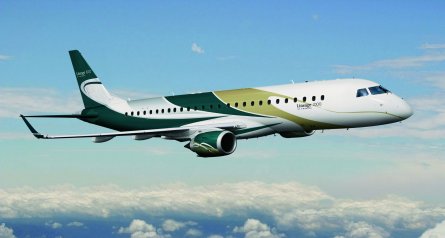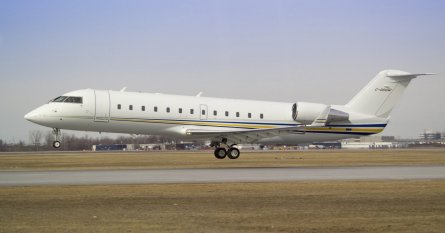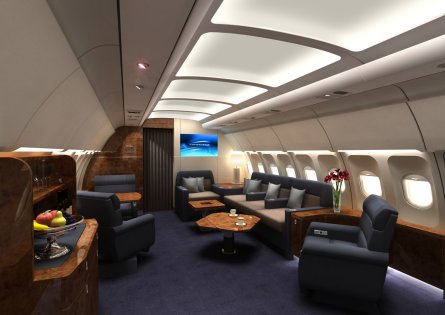Graham Warwick / Washington DC
Additional Reporting by Murdo Morrison / Berlin
Virgin markets are rare opportunities for a business aviation industry accustomed to selling to repeat customers with strong brand loyalty. But the explosive growth of individual wealth in countries such as Russian and India is creating a different kind of demand.
Instead of the thoroughbred performance and individualised interiors preferred by North American customers, this new breed of business-jet buyer is looking for a large cabin at a reasonable cost. And brand loyalty – some would call it snobbery – is unlikely to be a factor in their buying decision.
The companies best placed to meet this demand appear to be the manufacturers of regional jets and small airliners that can be outfitted with spacious, but standardised executive interiors for prices well below those of “traditional” large-cabin business jets.
|
| Embraer's E-190 based Lineage 1000 offers standard cabin options |
This is the emerging market into which Embraer has pitched the Lineage 1000, a corporate version of its E-190 large regional jet and a direct competitor for the A318 Elite executive variant of Airbus’s smallest airliner. The European manufacturer has already booked orders for 13 Elites at about $45 million apiece, significantly cheaper than a long-range, fully customised A319 Airbus Corporate Jet (ACJ) at around $60 million.
Bombardier is also benefiting from the new market for large-cabin jets; demand for the Challenger 850 corporate version of the CRJ200 has restarted a production line idled by the collapse of airline demand for the basic 50-seat regional jet.
Functional transport
The Challenger 850 is a no-nonsense corporate shuttle or executive jet pitched at buyers looking for a functional transport with a large cabin and a range up to 5,400km (2,900nm).
|
| The no-nonsense Challenger 850 has revived the CRJ200 production line |
The first corporate shuttle version was delivered from Bombardier’s Montreal assembly line to a Calgary-based energy company in March, and within a few months the first executive version completed by Lufthansa Technik (LHT) in Hamburg will be delivered to a German customer. Midcoast Aviation in St Louis, Missouri, is completing two 850s – one executive and one shuttle – for Switzerland-based Comlux Aviation.
The market for “non-thoroughbred” business jets has meant that production of the CRJ200 airframe – which had virtually stopped – is now at one to two a month, two-thirds of them destined for VIP completion by LHT under a three-year, 17-aircraft deal signed with Bombardier last year. With six of these Challenger 850s to be completed this year, the Canadian manufacturer is hinting that the deal could be extended beyond the 17 aircraft. “We plan to make a decision very soon,” says Bombardier.
The Challenger 850 is still very much a niche product,” says Bombardier sales director for Germany and Austria, Eckhard Breuer. “But if your mission is two, three, or four hours, it is perfect. It has the same cabin as a Global Express and is really a budget alternative to a Global if you don’t require the range.” Europe, rather than North America, is driving demand for large-cabin business jets like the Challenger 850, with Russia in particular showing “tremendous interest”, says Breuer.
Standardised interiors are key to the value offered by the new breed of large-cabin jets, as limiting the buyer’s customisation options to selecting from pre-engineered designs reduces the cost and time for completion. This is where companies like Lufthansa Technik enter the equation.
LHT signed up to complete the Challenger 850 after the market to convert Airbus and Boeing airliners for VIP and head-of-state customers declined. “We asked ourselves what are we going to do,” says Claus Bauer, vice-president completions. “The market for airliner conversions smaller than Airbus Corporate Jetliners and Boeing Business Jets gave us access to a different customer base.”
The company now has five lines at Hamburg devoted to installing interiors and auxiliary fuel tanks in the Challenger 850, and will add a sixth this year. In addition, LHT has an exclusive contract with Airbus to complete A318 Elites, of which there are 13 on order and another 13 on option. The company offers two levels of standardised interior for the 14- to 18-seat executive version of the A318 – the Elite and Elite+. Completion time is four months, says LHT, which is quicker than for an ACJ.
Corporate market
Airbus introduced the A318 Elite in a bid to break into the North American corporate market, with LHT’s standardised interiors allowing the price to be held down to around the same as a Global or Gulfstream large-cabin jet. In fact, the aircraft has been most successful in Europe and the Middle East, with orders including three for Switzerland’s Comlux and five for Saudi Arabia’s National Air Services.
|
| LHT's pre-engineered interiors allow the A318 Elite to compete on price |
The first green A318 will be delivered to LHT late this year, and will enter service with Comlux as a VIP-configured Elite+ in April next year. The Swiss charter operator, which will also place an ACJ in service in June, sees “big potential in Russia for the A318”, says president and chief executive Ettore Rodaro. Comlux will also place its Challenger 850s in service for an “eastern European/central Asian” customer.
Boeing Business Jets (BBJ) still has an executive version of the smallest 737, the -600, on the drawing board, but has yet to find buyers to launch the aircraft, which is also targeted at the North American corporate large-cabin market. Instead, the company is working to launch BBJ versions of the stretched 737-900ER and convertible passenger/freighter 737-700C – both aimed at the Middle East.
“Our original market was corporate. We have shifted our focus to lifestyle,” says BBJ president Steven Hill. “We have studied a -600 for the corporate world, with adequate range and not all the amenities. I think we will get there at some point. At the moment demand exceeds supply, so we are looking at the high end.”
Lufthansa Technik, meanwhile, has extended its pre-engineered cabin concept to introduce the Leadership Select 737 VIP conversion, which offers lower cost and faster turnaround than a full BBJ completion – six to nine months compared with 12.
Airbus, for its part, is responding to the fact that the market for the A318 Elite has emerged in Europe and not North America by introducing improvements to the aircraft. Beginning in 2007, aircraft will be delivered with provision for one auxiliary fuel tank, giving the Elite an increased range of 7,590km, sufficient to fly 18 passengers non-stop from Paris to New York.
Embraer is now competing in the same market, with its E-190-based Lineage 1000 offering a 7,770km range with eight passengers for a sticker price of just under $41 million. Although the aircraft’s cabin is smaller than the A318’s, it is larger than a similarly priced Global or Gulfstream and big enough to provide five interior zones. The cabin is large enough to seat 13 to 19 passengers, and flexible enough to accommodate such amenities as a full-size bed and shower.
Interchangeable modules
The Lineage is being offered with standardised VIP and VVIP cabins, but to provide flexibility, Embraer plans to pre-engineer interchangeable modules for each of the zones, which will be offered as standard options. The Brazilian manufacturer will select a design house to help with interior configuration, but has not yet decided whether to complete the large-cabin aircraft in house and use an outside partner.
Embraer says the Lineage is low risk, and expects to certificate the E-190 derivative within a year. The aircraft is scheduled to enter service in mid-2008, and the manufacturer hopes to attract customers from among operators of other large and ultra-large jets – as well as new buyers in emerging markets such as Russia, where the airliner origins of aircraft such as the Lineage 1000, A318 Elite and Challenger 850 are not a concern.
Source: Flight International


























